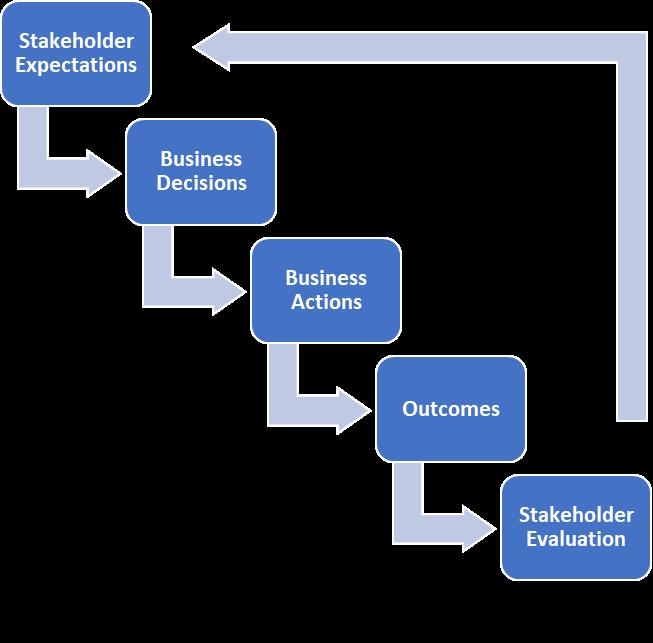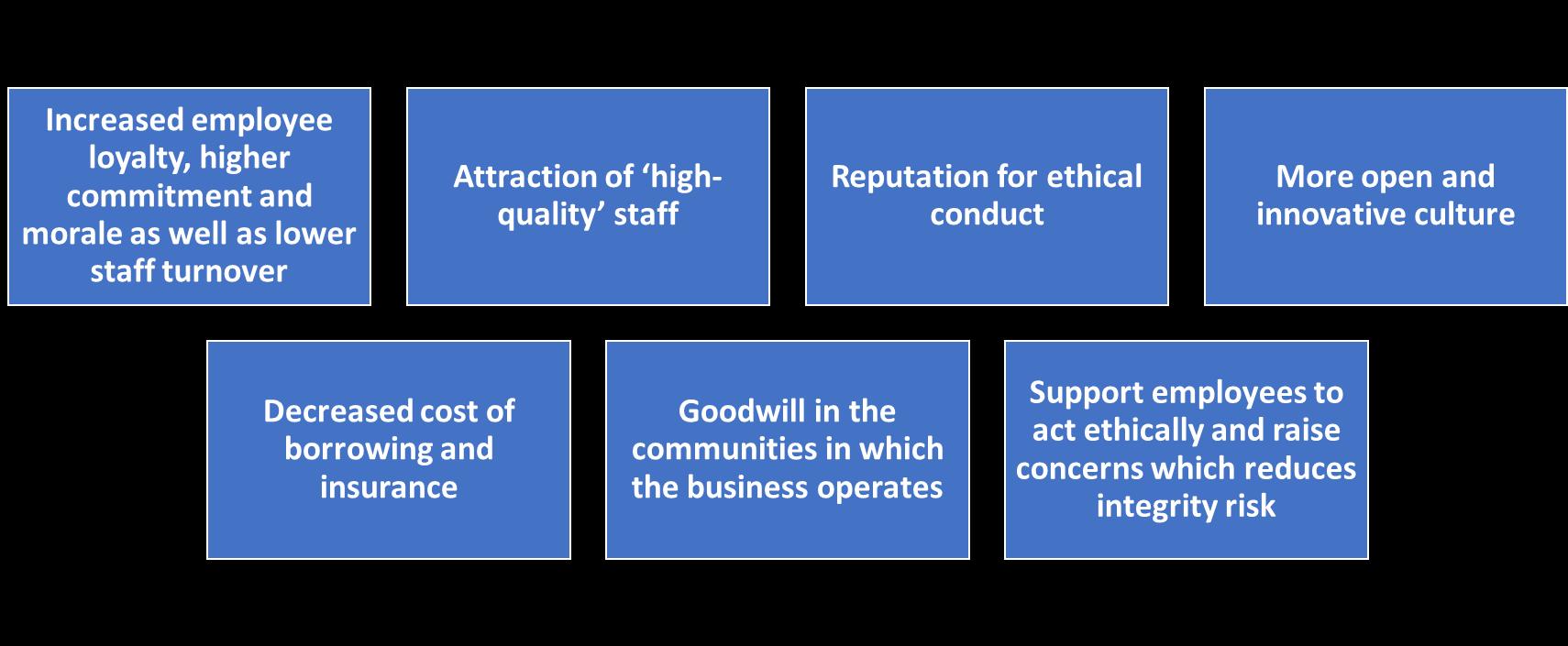Business Ethics in Leadership and Innovation VUC Storstrøm







The TITAN Project: An Overview……………………….……………..……………………………………...…3
Business ethics An overview 6
What is business ethics?....................................................................................................6
The sustainably responsible version of business ethics 7
Do we need business ethics? 10
Ethics in the SME…………………………..........................................................................11
Textbox 1: Examples of ethical dilemma in the SME 12
Textbox 2: Have you ever 13 Benefits of ethical conduct……………………………………………………………….…..….14
Four Design Principles for the Ethical Business 16
1. Empathy - Start (by) listening………………………………………………………………..17
Case: ATM Concrete Stakeholder Expectation Analysis………………………….…........18
Learning Activity 1: Stakeholder expectations 18
Textbox 3: Guidelines when engaging in an equal dialogue with the stakeholder….….....20
2 Ethical leadership 20
3 A business code of ethics Purpose beyond product 22
Case: Domestic Electrician Business - Environmental sustainability……………..………..23 Case: ATM Concrete Four pillars 24
Case Analysis: ATM Concrete - Four pillars 25
Learning Activity 2 A code of Ethics………………………………..…………………..........25
4 Partnership for sustainability 26
Textbox 4: Quote by Larry Fink…………………….…………………………………………..26
Case: ATM Concrete Innovative Partnership………..……………………………...………27
Case Analysis: ATM Concrete Innovative Partnership 27
Learning Activity 3: Response to stakeholders………………………………………...........28
Ethical decision making 30
Learning Activity 4: The Dilemma Star 32
Case: ATM Concrete - Dilemma about fair working conditions…………………...………33
Case Analysis: ATM Concrete Dilemma about fair working conditions 33
Learning Activity 5: Ethical decision-making 33
Summary……………………………………………………………………................................................…34
Resources and References 36
The overall aim of the TITAN project is to support small business ownermanagers, and their staff, to acquire appropriate sustainably responsible leadership and innovation skills which can implemented in a working context, as a way of achieving sustainable development goals alongside delivery of value to customers and other stakeholders
The TITAN project will achieve this aim through the development and delivery of a curriculum consisting of a set of complementary learning materials and resources including:
• A set of competence matrices, or modules, related to different aspects of sustainably responsible leadership and innovation
• A number of learning materials and resources (e.g. flipbooks, video guides)
• A set of assessment tools for small business owners managers and their staff
• An open educational video resource.
The TITAN curriculum will enable small businesses and organisations to:
• Identify different ways of introducing and embedding sustainability in their business models
• Assess strengths and areas for development within their business
• Explore processes and practices which can be used to implement and embed sustainability
• Learn from the experiences of different businesses and organisations who have introduced sustainability in their business models and processes and practices.
A number of themes, or modules, underpin the TITAN curriculum including:
• Sustainably responsible management
• Business culture for sustainability and innovation
• Business ethics in leadership and innovation
• Embedding sustainability in business processes
• Business responsible innovation
• Holistic approaches to innovation.
Sustainability leadership is defined as ‘a process of influence that delivers direction, alignment and commitment, and aims to address social, environmental and economic issues to create a better world’ (McCauley, 2014) and sustainable leaders are ‘individuals who are compelled to make a difference by deepening their awareness of themselves in relation to the world around them. In doing so, they adopt new ways of seeing, thinking and interacting that result in innovative, sustainable solutions’ (Sustainability Leadership Institute, 2011).
Over the last five years or so, there has been an increasing number of articles, books and papers published on different aspects of how small businesses can embed sustainability into their business models and specific business processes and practices These come from academic institutions, research institutions, policy and professional bodies and business and entrepreneurship magazines. Whilst these articles, books and papers provide valuable insights into the case for introducing and embedding sustainability and generic tips and techniques, they can often be difficult to access and tease out the practical implications for introducing and embedding sustainability, particularly for small business owner-managers and their staff. There is a lack of tailored, or demand led resources which can assist small businesses in understanding current strengths and areas for development, making sense of the importance of different opportunities in their task environment to introduce sustainability and manage the journey from idea to action.
The flipbooks have been designed to address this gap. There are six flipbooks which relate to the key themes underpinning the TITAN curriculum, and they provide:
• An accessible overview of the state of current thinking
• Insights from other small businesses who reflect on what works well and less well in introducing and embedding sustainability into their business models
• Access to exercises to support reflection on own learning and skills development
• Access to useful resources on different aspects of introducing and embedding sustainably responsible leadership and innovation.
The flipbooks are complemented by:
• A series of TEDx-type videos which reflect on different aspects of sustainably responsible leadership and innovation
• A range of micro learning activities which provide you with an opportunity to assess your own understanding, behaviours and skills
This flipbook explores ethical leadership and the development of an ethically responsible SME. You will learn how to improve your ethical leadership and make decisions responding to internal and external expectations to the SME on the path towards sustainability
Why do banks offer loans free of interest and establishment fees to houseowners wanting to make their homes more energy efficient? Why are companies of all kinds of trades frequently faced with scandals and eruptions of bad publicity emerging almost overnight? And how has sustainability become the yardstick of almost every kind of business performance, not only to the costumers, but indeed to all business stakeholders? It is all about the decisions business managers and employees make in daily operations and at a strategic level to eventually fulfil their business purpose. It is all about how owners, consumers and society in general judge these decisions in terms of right and wrong. It is all about Business Ethics.
Business ethics originally emerged as an independent academic field of study in the early 70’s and may be seen as a branch of Corporate Social Responsibility (CSR). Business ethics could be defined as “ … a form of applied ethics or professional ethics, that examines ethical principles and moral or ethical problems that can arise in a business environment. It applies to all aspects of business conduct and is relevant to the conduct of individuals and entire organisations These ethics originate from individuals, organizational statements or the legal system.” (1)
Business ethics is a set of moral values or principles existing inside the business about what is right, fair and just (2) for both the business and society in general In a business, certain business values exist that may have been formalized as an explicit code of conduct (also known as code of ethics) for the business. Or the values may exist only as a normative standard for behaviour expressed verbally by the management.
Every employee in the business can contribute to shaping the values or principles of the business. However, this material will focus on how the manager can integrate ethics both as a decision maker and as a role model. To establish whether business decisions and actions are right, fair and just( ifiable), the manager must consult not only an inner moral compass, but also the expectations of others both inside and outside the business. External stakeholders such as costumers expect businesses to do the right decisions about environmental sustainability, to be fair to employees and the surrounding community, and to be able to justify at least in principle every decision and action made
(1) https://en.wikipedia.org/wiki/Business_ethics Aug. 29 2022
(2) Jamnik, A.: The Challenges of Business Ethics, Tourism and Hospitality Management, vil. 17, no. 1 2011. https://papers.ssrn.com/sol3/papers.cfm?abstract_id=2062389
The ethical manager aims to do what is right, fair and just The concept of sustainably responsible leadership suggests ways to achieve exactly that. So, let us take a closer look at the words ‘sustainable’ and ‘responsible leadership’ in this understanding.
Responsible leadership is about responding to stakeholder expectations (3) The responsible manager knows the full array of stakeholder groups of to the business as well as the expectation of each stakeholder group to the business (see Figure 1 below). A stakeholder group, or just ‘stakeholder’, can be defined as any individual or group of people with an expectation for the decisions made and the actions done by the business Stakeholders to the SME could be employees, costumers, owners, suppliers, business partners, neighbours, the surrounding community, local and national authorities, NGO’s, influencers and popular profiles on social media etc. The responsible manager acknowledges the fact that stakeholder expectations require management
(3) Svensson, G. & Wood, G.: A Model of Business Ethics, Journal of Business Ethics, Vol. 77, No. 3, pp. 303 322, 2008. https://link.springer.com/article/10.1007/s10551 007 9351 2

‘
Management decisions and actions must be taken in order to respond appropriately to these expectations and to make balanced decisions, when dilemmas occur. Business outcomes are evaluated by the stakeholders to either reaffirm or create new expectations. Knowledge of stakeholder expectations forms the basis for decision making and the ability to constantly monitor and respond to stakeholder expectations is a central part of the business plan
Sustainably’ is an adverb derived from the adjective ‘sustainable’ which in this context describes a process that can be carried out or a condition that can exist without doing any harm and even doing good. An example of ‘doing no harm’ would be zero-emission production An example of doing good would be carbon capture technologies integrated into the production process.
We distinguish between ecological, social and economical sustainability (often referred to as green, red and black sustainability respectively). The United Nations’ sustainable development goals (4) mirror this distinction by pointing out both ecological, social and economical benchmarks. Sustainability in the SME is not only about green initiatives like recycling or power efficiency, but also about creating motivating jobs, a healthy work environment, positive relations to the surrounding community, and other social initiatives Furthermore, the SME has a right to sustain itself by building a financial basis to operate in the market and secure both revenue and jobs.
Sustainably responsible management is almost per definition ethical management. The sustainably responsible manager aims to achieve sustainable business results such as reduced ecological foot print or successful cooperative recruitment programmes for socially marginalised groups as a response to stakeholder expectations. In doing so, the manager becomes an ethical manager, because sustainably responsible business decisions and actions are either right, fair or just – or all of the three at the same time – in the view of most stakeholders.
These learning materials unfold some of the benefits of ethical leadership based on sustainable responsibility. They provide inspiration and tools to improve your ethical leadership and build an ethical business The ethical manager will inevitably run into ethical dilemmas. The right thing to do in the eyes on one stakeholder may be considered wrong or unfair by another. The last section below suggests a general method for analysing a dilemma to make better decisions when interests contradict.
(4) https://sdgs.un.org/goals Aug. 29 2022


Today, businesses are expected to do what is right, fair and just Obeying the law does not in itself prevent the occurrence of “grey areas” where actions taken may be legal, yet ethically dubious.
Public opinion about businesses is largely shaped by frequent stories of companies acting unethically without actually breaking any law. International companies with investment and business activities in Russia faced a huge dilemma, when the war broke out in Ukraine Should they maintain or terminate their involvements in or with Russia? Should they carry on in the attempt to make a return of investments and thereby run the risk of being accused of violating fundamental human rights or getting “blood on their hands”? Should they choose profit over ethics? Some companies maintained their operations arguing that it would hurt Russia more to keep control over the assets instead of leaving them to the Russian government. Other companies referred to core values about the responsibility for employees’ livelihoods by securing their jobs and steady incomes The companies comply with government sanctions and indeed try to justify their positions using ethical arguments. Still, trust in these companies has rapidly declined and investors are reconsidering their involvement In fact, public trust in businesses is decreasing while expectations of businesses taking social and environmental responsibility is increasing.
The general tendencies of rising distrust and expectations also affect smaller businesses operating on a local or national scale SMEs are also expected to do what is right, fair and just. But how do ethical dilemmas play out in the SME? Let us have a look at a few examples (Box 1).
• Would you raise the charge for your services or goods without a corresponding raise in your costs?
• How would you react if an employee tells you about several examples of a colleague taking a nap in the car during workhours and the employee wants to remain anonymous?
• Would you ask a key employee to work overtime to secure an urgent delivery when she is currently suffering the sorrow and loss of her mother’s recent death?
• How would you respond when securing an important contract seems to require the payment of a kickback?
• How would you react if a supplier invites you to contract negotiations at a fashionable ski resort?
• Would you delay due payments to creditors if your cash flow is currently limited?
• Would you meet a deadline with your customer and ship out products even though you know there is a possibility the products might be faulty, or would you openly discuss your difficulties with the customer?
• Would you fire a valuable employee who refuses to stop spreading rumours about a group of other employees?
Maybe these examples do not exactly resemble situations from your work life, but you have probably encountered similar dilemmas.
Think of couple of ethical dilemmas from your work life. How did you solve the dilemma? Did you give priority to business conditions, ethical conditions, or both?
Now, how do you respond to such a dilemma in a given situation? This is hard to say before you are actually confronted with the dilemma in real life. Just in case you are feeling very virtuous because you know you would always make the ethical choice in those situations, please ask yourself the questions in textbox 2.
Textbox 2: Have you ever…
• lied to your mother? your employees? the Inland Revenue?
• lied so you wouldn’t hurt someone’s feelings?
• lied to get out of a business or social engagement?
• taken a questionable deduction on your income tax?
• fudged figures on a report to make the results look better?
• taken a sick day when you weren’t sick?
• lied to a customer (“we sent your order yesterday”) or creditor (“the check is in the mail”)?
• cut corners on quality control?
• blamed someone else for something you knew you were partly responsible for?
• used any of these phrases: “Everybody does it,” “It’s the lesser of two evils,” “It’s only a little white lie,” “It doesn’t hurt anyone,” “Who will know?”
• put inappropriate pressure on others? (5)
We now have a sense of the nature and implications of ethical dilemmas in the SME. But is it really worthwhile to think about ethics in your business? After all, it could take resources to build or improve an ethical workplace culture and invent and implement new work procedures aligned with a set of ethical principles. You probably acknowledge the importance of good, trusting relationships with customers, employees, suppliers and the community. But this is not the only reason for investing in an ethical workplace culture and defining explicit ethical values for your business.

We all know the familiar sight of a van from a local builder or auto parts supplier that we come across often enough to recognise the name and logo of the business on the side of the van. For this business, it is quite important that people remember their name and their logo and sometimes even their phone number But it is even more important what sort of emotions the name and logo create because emotions form the public reputation and the brand of the business. In fact, all resources spent on PR are wasted if not directly counterproductive when the brand perception or the reputation of the company is negative It is impossible to create a strong brand just from being seen a lot. To create a good reputation, it is not sufficient that people notice your van. They should also start smiling. To achieve this, your business needs a reputation for ethical leadership. The call for business to act ethically is heard from numerous sides. The CIMA Institute (6) advices every SME to device a code ethics or similar guiding principle to provide support to employees on how they are expected to conduct their business. Based on research and experience, the CIMA Institute has created a comprehensive list of benefits of ethical business conduct for the SME (see Figure 2 below)
Figure 2: Benefits of acting according to an explicit code of ethics
Taking an ethical path must be grounded in an inner conviction of the owners and/or managers and intrinsic leaders If ethical procedures are conducted solely to gain a market advantage, the procedures are instrumental and cannot be called ethical.
This learning material will provide a set of design principles on how to get started with or how to improve ethical conduct in your business

Running an ethical business always implies continuous listening to the true needs and desires of every individual, every group of individuals, and every organisation who takes an interest in your business. The needs and desires of these stakeholders shape their interests and expectations to your business. Running an ethical business means responding to these expectations And stakeholder expectations matter. If costumers expect your product to be sustainable, it will dramatically affect your market position, if it is not. If employees do expect to be appreciated for doing a good job yet never receive appreciation, they probably will probably just do the job without real commitment
The number of potential stakeholders of your business is virtually unlimited if you consider every action performed by yourself and your employees and every physical or social impact made by your business. Society at large benefits from the success of your business in the forms of job creation, value creation, taxation etc. And likewise, a countless number of individuals and organisations may potentially suffer indirectly from your business’ emission of carbon dioxide or purchase of unsustainable supplies.
To make an analysis of stakeholder expectations operational, you must start by identifying the most important stakeholders of your business. Key stakeholders include every group of immediate importance to the survival your business, for instance customers, owners, employees, and various government authorities. Key stakeholders often express quite clear and explicit expectations Other stakeholders are more important for the long-term economic sustainability of your business in terms of storytelling and good will. This group may include the local football club looking for a donation, the residential neighbours expecting you to reduce noise and keep the community tidy, or the public employment service expecting you to take responsibility for reemployment of citizens Both groups are important to acknowledge if you want to do good for both your business and society in general. You are probably quite aware of the expectations of your key stakeholders and how to respond adequately. Responsible leadership lays it upon itself to investigate a wider range of stakeholders important to the business and determine what they expect from business. It is useful to create an overview of significant stakeholder expectations to guide strategic and operational decision making and innovation. And it may improve your ability to provide a good and fair response to any present or future stakeholder of your business.
Who
ATM Concrete manufactures custom made concrete elements for the construction industry. The business resides in a small town in a rural area where it was founded right after WWII. It remained a classical owner-manager business for some decades until it gradually shared both ownership and senior leadership.
In 2014 senior management was taken over by two young CEOs, one being the grandson of the founder, the other being of academic background and an out-sider to the industry. In 6 years, the business grew from 16 to 85 employees, and in 2021 it merged with two small specialized concrete businesses abroad.
Browse this Stakeholder Expectation Analysis of ATM Concrete. Develop your own list of important stakeholders and what they expect from your business by filling in columns 1 3 in this Stakeholder Expectation Analysis.

are the most important stakeholders of your business? Have their expectations changes over the years? Have any new stakeholders emerged recently?
If you are not sure what expectations a particular stakeholder might have, you will have to do some investigation. New expectations are typically formed when you decide to change something which has existed for a while This change will affect one or more of your business’ stakeholders and give rise to new expectations. Let us consider a few examples.
If a business situated in a village decides to cut down some old trees at the far end of the property to make room for a new warehouse, it could create discontent in the local community for various reasons (e.g., recreation, wildlife protection, climate shield). If this is not dealt with, the discontent could harm the relations between the business and members of the local community. They will lose expectations of being taken into account in future business decisions which they feel affect them in some way. If not dealt with, the discontent could grow into organised counteraction which could eventually jeopardise the plans for the warehouse and other future actions intended by the business.
A business has received a demand from its biggest regular client to remove an environmentally damaging heavy metal from its alloys. The replacement increases the price of the product with 28%. The client is willing to pay the difference, but smaller clients will most likely complain. In this case, expectations to your business will change for at least one of the clients no matter if the change is implemented or not.
A responsible way to deal with uncertainties about expectations is simply to ask the stakeholder directly. Most people like being asked about their interests if the asking is done in a respectful way Engaging in direct dialogue can reduce conflict escalation and is prerequisite in reaching a proper solution. It gives both parties a chance to state their case and dig beneath the apparent interest to search for the underlying needs and desires, which can only be appreciated when disclosed Engaging in direct dialogue is not a promise of any specific action by the company but an attempt to reach out for a common solution. The legitimate needs and desires for the business would eventually be to survive and do good for the business and for the stakeholders. For the business, this forms an ethical basis for an equal dialogue.
1. Be a good listener. Listen actively by asking inquiring questions to uncover the needs and desires of the stakeholder. Keep the focus on the other until clarity is reached. After this you can state your business interests and needs. Don’t be the one talking all the time.
2. Accept different views. Even a seemingly outrageous claim has its reasons. Keep an open mind and make sure not to jump to conclusions or framing the other.
3. Give yourself time to reflect upon the situation and to weigh business interests against ethical interests. Call a time out if needed.
4. Never use the word “you” unless you put a question or refer to your own needs and use the word “I”: I need you to understand…, I would be very pleased if you…, Could I ask you to… . Never say what others should do or think unless they ask for your opinion.
5. Be open and honest. Be open about the reasons for your approach and honest about what you can promise.
Should you raise the charge for your services or good without a corresponding raise in your costs? Should you ask a key employee to work overtime to secure a delivery when she is currently suffering the sorrow and loss of her mother’s recent death? These are examples of the dilemma of balancing business interest (profitability, reliability) with ethical interests (fairness, respect). Managers are confronted with such dilemmas every day. The actions chosen in each particular situation are determined by the moral values of the person making the decision.
Most managers would agree that their actions and decisions are guided by a set of personal moral values that they stand for and attempt to live by in everyday life and at work. It is easy to believe that acting according to certain values, e.g. fairness and respect, will automatically spread to the rest of the business like ripples in water. But a moral person being a manager doesn’t necessarily make a moral manager or an ethical business. It is the other way around: A business with an ethical brand takes ethical leadership, and that takes a moral manager.
In a famous article, Trevino et al. (7) argue that ethical leadership rests upon two pillars (see figure 3 below). The first pillar describes an example of the manager as a person who holds a specific set of moral values. Some managers are driven by an inner conviction and are probably very aware of their moral values. Others are not, even though the values are tacitly present. In any case, the moral person internalizes a personal moral code, whereas the manager attempts to impose a moral or ethical code onto others by encouraging or demanding a certain behaviour.

We are all guided by a belief in what is right, fair and just; a belief reflected in our behaviours and what we choose to do. A moral person is inclined to do good for humanity. A moral person becoming a manager will look for ways to combine the concerns for the business with concern for people. Decisions are made based on the moral values of the manager. Consistent decision-making secures predictability and reliability. Therefore, it is important for the manager to know his moral values and make decisions according to them.
What are your personal moral values? How do they affect your behaviour and your decision-making?
(7) Trevino L.K. et al.: Moral Person and Moral Manager: How Executives develop a Reputation for Ethical Leadership, California Management Review, Vol. 42, No. 4., pp. 128-142, 2000. http://homepages.se.edu/cvonbergen/files/2015/01/MoralPerson and Moral Manager_How Executives Develop a Reputation for Ethiccal Leadership.pdf Jul. 13, 2021
Figure 3: Ethical leadershipThe second pillar describes what a manager must do to become a moral manager. It is not enough to be a moral person doing management. Ethical leadership is only accomplished when processes to develop and maintain the ethical business are managed specifically with the intention to actively influence the behaviour of others The moral manager makes his ethical standpoint visible to internal and external stakeholders by communication about key decisions. If the manager wants a certain set of core values to be embedded in the business, that is to guide and shape a certain workplace culture and employee behaviour, an explicit code of ethics for the business must be developed.
How do you perform ethical leadership?
Do you actively attempt influence the behaviour of your employee according to certain principles?
What do you stand for as a person? How are your standpoints reflected in your daily work? Are you open to revise your view on things? These are the most important questions to ask yourself when you identify ‘the way we work’ or ‘how we do business’ . The answers to these questions underpin the fact that you are in business not only to produce quality product and be profitable, but also to do it in a certain way. Your business has purpose beyond its product.

Jens is the young owner manager of an electrician business of around 20 employees. Becoming the father of his own children motivated him to work for a better environment.
So, he started looking for ways to capture and recycle all waste and excess materials produced by the business both on the workshop premises and during service tasks for customers and clients. It quickly grew into a meticulously sorting of all business waste to a degree far beyond the public waste recycling system. All business vans are installed with a set of sorting baskets, and employees are instructed to clean up after each step of the work process to keep waste materials separate. The materials are resold or given away to the local football club for further disposal. So far the effort is far from profitable. Some of the workers find Jens’ ideas a little funny and somewhat time consuming, but Jens continues his pursuit with a smile and a quiet talk with the staff about his priorities. After all, it is just about slight modifications of habits.
What is Jens’ purpose beyond product? How does the business fulfil this purpose?
What is your purpose beyond product?
The core values of a company can roughly be divided into two categories: 1) business values, which express qualities of product, production and service, and 2) ethical values, which describe the way in which the company works. Figure 4 shows typical examples of both types of values. A code of ethics may be defined as a specific set of ethical values that describe principles for 'the way we work' and 'our purpose beyond the product', e.g. 'We do things properly'. The distinction between business and ethical values applies only in theory. Ethical values such as honesty and fairness can be considered part of the product especially for service providers. Likewise, a quality product that is built to last is both environmentally sustainable and value for money. In fact, the distinction is increasingly difficult to make as more and more customers and other stakeholders do not.

Quote from a CEO of ATM Concrete: “We never discussed ethics. We are more concerned about employees being proud of what they do. We succeeded when employees recommend us to friends and family.”
The vision and main business purpose of ATM Concrete is, that every future target group contractor in the world will request for a quotation from ATM Concrete when planning a new project. To obtain this, we need a green agenda. We will never reach number one if we are not fair. We have never put anything in writing, but everything we do rest on four pillars: Quality Pride Integrity and honesty Sustainability”
The four pillars of ATM Concrete are examples of core values. How would you label each value in terms of business values versus ethical values? Can you draw up a code of ethics for ATM Concrete?
Quality is related to the product and therefore a business value. Pride, fairness and honesty describe the way things are done and how the business is run without being a part of the product. These are ethical values. Sustainability could be both depending on what is meant by the word. If it means economic sustainability mediated through economic strategies (‘black sustainability’), then sustainability is a business value. If it means environmental (green) or social (red) sustainability, then it is an ethical value. A code of ethics for ATM Concrete could revolve around these ethical values: Pride Integrity and honesty Sustainability (red and green)
Learning Activity 2: A code of Ethics Develop a code of ethics for your business by using this simple tool
In the SME, the owners and/or managers will typically attempt to shape the business culture and environment according to their interest. The moral manager will include employees and owners in the development process to create ownership and make the code of ethics translate into action. Please refer to relevant TITAN course units to learn more about embedding values in the business plan and in the business culture.
Once a code of ethics has been created, it is necessary to constantly keep listening for any changes in stakeholder expectations. The responsible SME manager will use the code of ethics to guide the response to external stakeholders.
An overview of important stakeholders, a curiosity for their needs and desires, and a clear idea of your own standpoint and interest form a solid base for you to initiate partnerships with internal and external stakeholders.
Textbox 4: Quote by Larry Fink from his 10th annual Letter to CEOs, January 2022 (8)
Stakeholder capitalism is not about politics. It is not a social or ideological agenda. It is not "woke." It is capitalism, driven by mutually beneficial relationships between you and the employees, customers, suppliers, and communities your company relies on to prosper. This is the power of capitalism
Fink, CEO and Chairman of BlackrockFew SMEs are directly involved with Blackrock, the largest hedge fund in the US. Still, it is worth taking heed of the advice given by its CEO Larry Fink, who may be seen as the world’s greatest private investor, in his annual letters to CEO all over the world. Predictions in these letters have proven to be quite reliable. Good partnerships are to the benefit all partners, and they may give your business the opportunity to serve a purpose beyond product and profit, without compromising business values or imposing negative economic consequences for your business.
LarryAt ATM Concrete, production methods are highly specialised, and the business must train new employees and provide them with unique skills required in each stage of the process. Senior management discovered that dedication and eagerness to learn new skills was more important than certified skills acquired though conventional education. They found the desired traits among people in risk of social marginalisation and got inspired to outline of a tailormade recruitment program. They reached out and formed a partnership with the Public Employment Service, the Language Training Centre, and the Prison and Probation Service to create a training program for clients of these services. The program combined activation, integration, language training, skills assessment, and specialised workplace training. Around one third of the current staff has been recruited this way. ATM Concrete has been awarded a national CSR-prize for this effort.
Name the stakeholders of ATM Concrete in the case above. How does the partnership benefit ATM Concrete, each of the stakeholders, and society at large? How does this partnership reflect the code of ethics of ATM Concrete?
Public Employment Service, the Language Training Centre, and the Prison and Probation Service are the three stakeholders, who all benefit from the partnership. The program helps these public services achieve important internal objectives. The synergy of the partnership is a good ’result’ for the individual trainee and for society in general: Unemployed citizens at the edge of both labour market and civil society are given a chance to pursue a decent livelihood and contribute to uphold public welfare through tax paying. ATM Concrete has not yet defined a purpose beyond product, but this effort certainly serves a purpose in a realm exceeding narrow economic business purposes. The effort is a live manifestation of all three values in ATM Concrete’s code of ethics.

The social responsibility taken by the management is in alignment with specific social sustainable development goals issued by the United Nations. The initiative sprung from the CEOs’ belief that everyone should have a fair and equal chance, and that the business could provide this and secure a specialised and loyal work force at the same time The recognition has contributed to the business’ reputation for taking care of people and made it employees proud of working there.
A partnership is fostered by a good idea. It is easy for the manager to define his expectations to potential partners To engage in an equal dialogue, it is just as important to respond to expectations of the potential partners. Stakeholder expectations are usually not forwarded directly to the individual business, but rather as a common address to the business community. For instance, Public Employment Service expects businesses to cooperate in securing occupation for the unemployed Normally, such an expectation would not be expressed directly by a PES-representative to you, unless you were already engaged in some kind of cooperation. But you could always take your time to imagine what a stakeholder and potential partner like the PES would expect from you. By anticipating expectations from stakeholders, you are prepared for building positive relations or even initiate innovative partnerships that will last because they meet the expectations of you partners as well as you own.
In the case example above, ATM Concrete managers had anticipated that both the PES and the Language Training Centre hoped to help clients integrate into the job market. Their response was to contact these to stakeholders and form a successful partnership. This would not have happened if ATM Concrete had not taken a proactive stance. They started by preparing a their response to stakeholder expectations.
Open your document Stakeholder Expectation Analysis from Learning Activity 1. Develop your own overview of your responses to stakeholder by filling in boxes in column 4 for each stakeholder.


A dilemma can be defined as a choice between two equally desired or undesired options, sometimes referred to as the horns of the dilemma A business dilemma occurs when achieving a business objective implies two contradictory conditions leading to actions that mutually make each impossible.
Let us reconsider an example from Textbox 1 about delaying due payments to creditors when cash flow is momentarily limited For the manager with the objective of running a successful business, this situation represents a dilemma which can by graphically illustrated by a starshaped model inspired by Robinson et. al. (9) (see Figure 5).
Figure 5: Graphic illustration of a dilemma
The objective is to run a successful business Running a successful business implies concerns for both the finances and the reputation of the business. In this case, securing finances would mean delaying the payments, while securing reputation would mean prompt payment. The two conditions contradict, because the lead to actions that cannot both be done The solution depends on the circumstances and the moral values of the person deciding.
This is an example of a generic model, ‘the dilemma star’, that could be applied to describe and analyse most business dilemmas. To make the model operational, each spike of the star has a letter: O, X, Y, Z, -Z and S Figure 6 explains the meaning of each letter.
(9) Robinson, D. et al. How entrepreneurs deal with ethical challenges an application of the Business Ethics Synergy Star (BESS) technique, Research Gate 2007. https://eprints.qut.edu.au/5623/1/5623_1.pdf 03.11.2022

The model does not promise an automatic solution to the dilemma. This will always require a decision The model aids the decision-maker in getting a clear view on the conditions before instead of impulsively choosing what seems right at first glance. Most dilemmas require a decision that will favour one condition and rule out the other. Sometimes, however, the clarification itself may give inspiration solutions favouring both conditions and even give rise to second thoughts about the objective.
A dilemma is a consequence of a given objective. In the example above about paying or not, the dilemma occurs because of the objective of running a successful business both economically and ethically For a business with little or no concerns for its reputation, there would be no dilemma.

Consider a few other dilemmas from textbox 1. Complete this learning activity to analyse each dilemma.
Ethical business dilemmas often occur as a juxtaposition of a business condition against an ethical condition as it is in the example above. In this case, X is the business condition (secure finances) and Y is the ethical condition (secure reputation). This dilemma is essentially a question of making the ethical choice or not If both X and Y are business conditions the dilemma is not an ethical one, but a pure business decision If both X and Y are ethical conditions, we have a purely ethical dilemma.
The staff includes people representing different ethnic minorities. A cherished and experienced worker representing the ethnic majority has started rumors about minority workers, claiming that they are less valuable and do not belong in the business. At work shifts this worker refused to share work tool with minority colleagues. A CEO made it clear to the worker that racism would not be tolerated. The worker did not stop and received a second warning before finally being dismissed.
In accordance with its code of ethics, ATM Concrete has an objective of integrity which implies being fair in every manner. This includes fair and socially sustainable working conditions for every one. Figure 7 describes the dilemma.
X and Y are both ethical conditions, and the dilemma is purely ethical. It was a complex decision because firing a senior employee could jeopardise the trust in safe employment in the peer group of the employee. Good relations to every one of the staff are material to the CEOs in their pursuit of building a workplace to be proud of with fair conditions for everyone. Therefore, attempts were made to make the employee change his behaviour and keep his job. In the end the concern for an equal culture with positive relations determined the solution.

Use this tool to describe and analyse two or three dilemmas that you have recently experienced or may be facing right now.
Figure 7: Graphic Analysis of dilemma about fair working conditionsDiscussions about what is right and what is fair have never been mediated in scale like today. And a growing number of the world population is watching and contributing. Social media, public service media, and printed media are flushed with stories and information to substantiate public opinion on most everything. Quite often, businesses are the centre of stories on broadcasted or social media threats and a constant evaluation of business conduct is going on in both global and local fora.
With increasing expectations of social and ecological sustainability from both internal and external stakeholders, the business needs to build a reputation as an ethical business through ethical actions and decisions by every manager and employee in the business. Even in small communities, businesses are expected to deliver more than just high quality products and services. They are also expected to show concern for people and the environment.
Even though the manager or the CEO might be a person of high moral standard this does not automatically make the whole business ethical. Building an ethical business is a multifaceted process requiring special management efforts. To learn about or maybe even influence expectations to the business, the manager must engage in dialogue and partnership with stakeholders.
The moral manager must know what she/he stands for as a person and be able to express her/his moral values. Likewise, the ethical business must develop a code of ethics to guide behaviors and decisions made by management and staff when important decisions are made and in the daily operations.
The ethical manager consistently acts and makes decisions according to a code of ethics. The ethical manager applies methods for ethical decision-making to balance reason with impulse in turbulent times.

Follow the link and scroll to page 8 to view the checklist of 17 central questions about ethical leadership. https://www.cimaglobal.com/PageFiles/372602958/CIMA%20Embedding%20E thical%20Values.pdf
In this 5,5 minute video managing director Nick Bion at Bion & Co shares his 30 years of experience with developing ethics in his SME. https://www youtube com/watch?v=6iSElCejWrg
Click here to watch this 6,5 minute animated video from Global Ethics Solutions focussing on dilemmas and stakeholder implications. https://www youtube com/watch?v=ahH_P_5yVSo
Click here to watch this 4 minute animated video from Global Ethics Solutions explaining all key elements of business ethics https://www youtube com/watch?v=_sF1CEA-UUs
This 4 minute videocasted talk by Jennifer Bridges runs you through ‘what’s and ‘why’s for the ethical project manager https://www youtube com/watch?v=T6VIJhCuovI
Trevino L K et al.: Moral Person and Moral Manager: How Executives develop a Reputation for Ethical Leadership, California Management Review, Vol. 42, No. 4., pp. 128-142, 2000. http://homepages.se.edu/cvonbergen/files/2015/01/Moral Person and Moral Manager_How Executives Develop a Reputation for Ethiccal Leadership.pdf
Robinson, D. et al. How entrepreneurs deal with ethical challenges-an application of the Business Ethics Synergy Star (BESS) technique, Research Gate 2007
https://www.researchgate.net/publication/228375943_How_entrepreneurs_deal _with_ethical_challengesan_application_of_the_Business_Ethics_Synergy_Star_BESS_technique
McCauley, C. (2014) Making Leadership Happen, Center for Creative Leadership, Greensborough, North Carolina
Mirvis,P.H. et al: Responsible Leadership emerging. 2010. https://grli.org/wp content/uploads/2018/09/Responsible Leadership Emerging.pdf
Sustainability Leadership Institute (2011) Definition of Sustainability Leadership, cited in Visser, W. and Courtice, P. (2011) Sustainability Leadership: Linking Theory and Practice, Institute of Sustainability Leadership, University of Cambridge, Cambridge.
Svensson, G. & Wood, G.: A Model of Business Ethics, Journal of Business Ethics, Vol. 77, No. 3, pp. 303-322, 2008. https://link.springer.com/article/10.1007/s10551 007 9351 2
Székely, F & Knirsch, M.: Responsible Leadership and Corporate Social Responsibility: Metrics for Sustainable Performance, European Management Journal Vol. 23, No. 6, pp. 628 647, 2005. https://www.sciencedirect.com/science/article/pii/S0263237305001131?casa_to ken=ZMpuE27XcSsAAAAA:jSCYxG9VHLOGzGcRO_ybgyq6TFRNN34RrFERJ U9FrVHMKK48GMeX2c31ezeBdmbzuPlPjJgO1Q
If you're interested in reading more about sustainable leadership and innovation, you can find additional learning materials on the TITAN project website.


Website: TITAN | Project Transformation Training to Empower https://titan leadership.eu/

The European Commission’s support for the production of this publication does not constitute an endorsement of the contents, which reflect the views only of the authors, and the Commission cannot be held responsible for any use which may be made of the information contained therein.
Project number: 2020 01 UK01 KA204 079163